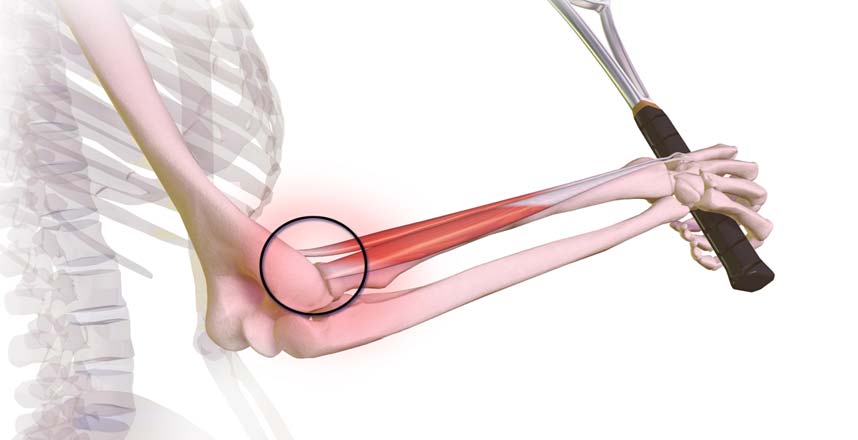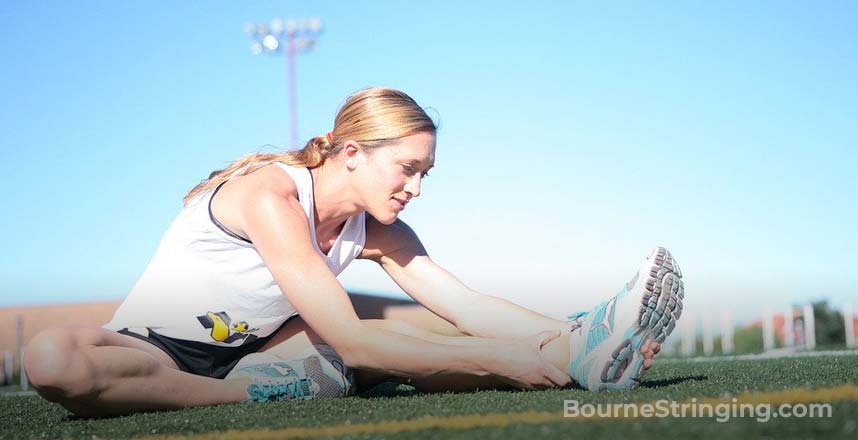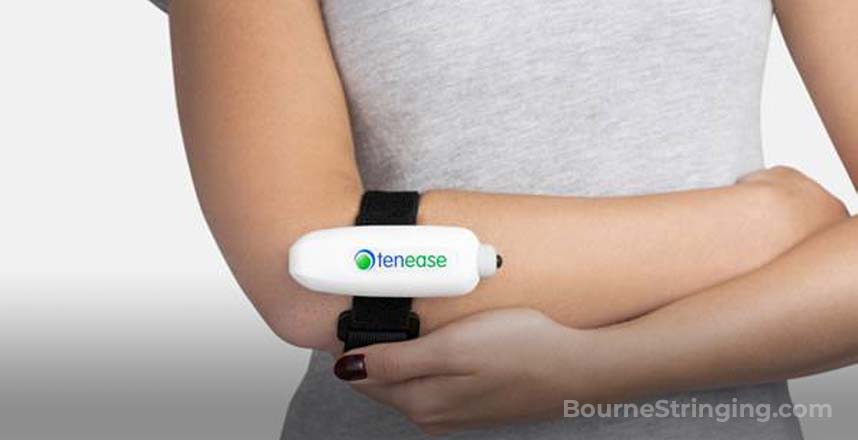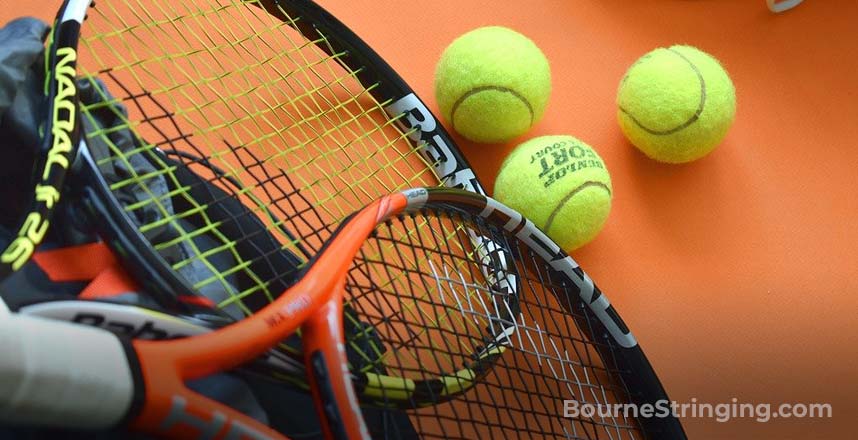
Tennis Elbow – Symptoms, Causes & Treatments
As someone who has suffered (and still occasionally suffers) from tennis elbow, I know precisely how much of a pain it can be – literally!
When it strikes, it can be excruciatingly painful, to the point where turning a door knob, opening a jar or anything that requires gripping is an incredibly uncomfortable experience.
Anyone who has suffered from acute tennis elbow will know that unless you regularly apply suitable treatments, it will keep you out of action for a considerable length of time.
In this comprehensive article, we explore the typical symptoms of tennis elbow, what causes it and most importantly, how to treat it effectively.
We’ll also cover some extremely useful changes you can make to your tennis racket set up that will dramatically reduce your pain, and put your troublesome elbow onto the road to recovery.
So let’s dive in and discover how you can get yourself back onto the tennis court quickly and pain free!
Article Contents
What is Tennis Elbow?
The tennis elbow is a very common condition which causes considerable pain in the elbow and arm area.
Tennis elbow is clinically referred to as lateral epicondylitis.
It is a type of tendinitis, which essentially means that there is swelling and inflammation of the tendons, which consequently leads to pain.
The tendons are the tissues which connect the lower arm’s muscles to the bone.
Tennis elbow is the most common ailment revolving around overuse of the elbow.
Despite the fact that many relate it to a condition that only tennis players suffer from, anyone can get tennis elbow even if they do not play tennis.
Generally tennis elbow derives from activities which involve repetitive excessive gripping, especially if the gripping posture is carried out by means of the first two fingers and the thumb.
Symptoms of Tennis Elbow
Tennis elbow leads to considerable pain as well as tenderness on the extensor muscles of forearm.
That pain is very noticeable if the soft tissue area around the elbow joint is touched by a finger or thumb.
In some extreme cases, you might also feel some pain in the forearm and in the back of the hand.
The pain can vary from mild discomfort when one is using the elbow, to severe pain even if the elbow is not being used or even moved.
Repetitive wrist or twisting movements, or when someone tries to extend the wrist to grip an object such as a jar lid or door knob, tends to make the pain considerably worse.
Some of the main symptoms related to the tennis elbow include:
- Pain just below the elbow, on the outside of the upper forearm. This pain may also move down the forearm, towards the wrist if the level of inflammation is severe.
- Pain that is experienced whenever one tries to lift or hold something.
- Pain caused when the arm is bent.
- Pain that is felt when one tries to grip small objects such as holding a pen to write.
- Pain is experienced whenever one tries to twist the forearm, such as when opening a jar lid, or when shaking hands, or turning a door handle.
- When one fully extends the arm it is common to experience pain and stiffness.

What Causes Tennis Elbow?
Tennis elbow often occurs when someone overuses the muscles and tendons, especially those situated in the forearm, which is close to the elbow joint.
The elbow joint is surrounded by muscles.
These are needed to move the elbow, as well as the wrist and fingers.
The tendons join the muscles to the bones, and they are responsible for the control of the muscles in the forearm.
When these muscles and tendons are strained or overused, you can develop small tears and inflammation in the lateral epicondylar region.
This usually occurs on the outside of the elbow.
When tennis players suffer from tennis elbow, a number of factors might be to blame.
These factor may include:
Lack of Stretching or Warming Up
Club tennis players are famous for their lack of warming up or stretching before play.
As a sport that’s played all year round, and at times in freezing temperatures, it’s imperative to ensure your body is sufficiently warmed and loosened up before play.
Many club tennis players simply go onto the court ‘cold’, then start to move and hit balls for extended periods and end up with a muscle tear, strain or impact injury, and then wonder why.
No matter whether you’re a tour pro or a budding amateur, stretching is a must.
Always stretch every muscle group for 10-15 minutes before play, focusing on areas that may feel tight or sore for longer periods.
Poor Technique
Every player is unique in the way they play tennis, whether it be their movement, posture, footwork, body work, swing technique or ball striking.
But the fact is, tennis elbow is an injury caused by the way you play.
If your timing and technique is poor, it is very possible that you may be framing the ball often.
On lighter or cheaper rackets, vibrations when ‘shanking’ the ball are prevalent and these can cause trauma and inflammation to tendons if this repeatedly occurs.
You may also be over-stretching or hyperextending for balls if your body is not positioned correctly to strike the ball cleanly.
Again, this may cause unnecessary strain on tendons and lead to inflammation if this occurs often enough.
If you’re concerned your technique might be a cause of tendonitis in your arm, speak to a professional tennis coach about improving your game.
Excessive Gripping
Club tennis players often like to place several over-grips on the handle to create a fatter, more pronounced grip size.
They do this believing this will help them grip the racket better and control the ball more accurately.
However, this is not necessarily true and there is a critical trade off to consider.
A fatter grip tends to force the player hold the racket handle tighter for prolonged periods.
As a result, this can lead to pulled tendons which will develop into tennis elbow if continued.
Players who are more relaxed and less tense are far less likely to grip the handle tightly and subsequently develop tennis elbow.
So instead of going up a grip size, try considering coming down to a smaller grip.
Racket Stiffness
Many modern players rackets are extremely stiff, with very pronounced wide throats and thick beams.
The current range of Babolat rackets are a prime example of this.
Whilst these racket do offer some excellent benefits including power, control, spin and stability, they also come with numerous pitfalls to amateur level players.
Professionals like Rafael Nadal for example, are highly trained athletes who have worked just as hard off the court as on, to develop their muscle groups to handle stiff beamed rackets like Babolats.
Rafa has some of the best ball striking and timing the game has ever seen, so it’s extremely rare to see him miss-hit or shank a ball.
So stiff frames like the Babolat Pure Aero enhance his game, and do not hinder him in any way.
Unfortunately, many club players see the likes of Nadal hitting blistering winners from all angles of the court, and immediately feel they need the same equipment as him to play just like him.
This couldn’t be further from the truth.
In almost all cases, power, spin and control is developed through years of intense training to perfect technique.
The racket has very little to do with it.
If your game is not of a standard good enough to use a modern professional players racket with a stiff frame and thick throat, don’t use one.
Stiff frames will lead to arm and shoulder injuries if used by players who are simply not good enough to use them, and continually miss-hit or frame the ball.
In short, the vibrations through stiff beamed rackets will destroy your tendons!
String Stiffness
Much like racket stiffness, the wrong choice of string can also lead to injury.
Yes, even that innocent looking material woven into your frame can cause injuries if it is strung too tightly or the choice of string material is too stiff for your game.
Many professionals endorse certain string manufacturers and types, most notably Luxilon, Babolat and Wilson.
Some but not all of these strings are incredibly stiff, and should only be used by players of an advanced standard.
Again as mentioned above, Rafael Nadal is a player who uses a very stiff bed of polyester strings in his Babolat rackets.
Most of the time, he uses a full bed of Babolat RPM Blast.
Just because Rafa uses this string, does not immediately mean that someone inspired to pick up the same racket frame as him should get their racket strung up the same as him.
A stiff frame combined with stiff strings, used by an amateur with poor technique is a recipe for disaster.
It’s only a matter of time until you injury some part of your arm, most likely your elbow.
A softer synthetic gut or co-polyester will play just a well and be far more comfortable.
Other Causes
Of course, it may not actually be the game of tennis that has caused the tendonitis in your elbow joint.
You may have indulged in other activities that has caused your elbow tendons to become inflamed, and tennis has merely made it worse.
Or you don’t even play tennis at all!
While tennis players may indeed suffer from this condition, this is not an ailment suffered exclusively by them.
Tennis elbow is a condition that is caused by all sorts of other sports and activities which leads to stress on the elbow joint.
This includes golf, squash, typing, knitting, playing musical instruments, painting, use of tools and machinery or even holding a pen and writing for extended periods.
These activities constitute repetitive motions of the wrist and arm, and could lead to developing tennis elbow.

Treatments for Tennis Elbow
The overriding issue with tennis elbow is the fact it is a slow healing injury.
Due to the area of the arm where the injury occurs, blood-flow to the tendons experiencing inflammation is limited.
Therefore, the lack of blood-flow reduces the healing process and thus, recovery takes far longer than similar injuries elsewhere on the body.
Avoid Activities
The first way to relieve pain experienced from tennis elbow is to examine common activities you engage in that cause it.
If you are performing certain activities which are leading to stress on the elbow joint, you should try to avoid such activities as much as possible.
In time, you should notice that the symptoms and pain will subside.
Diagnosis
If the pain persists or is considerable, it’s important to visit a doctor or medical specialist.
The doctor will check for swelling and any tenderness.
Generally, simple tests will be conducted to give you a full diagnosis.
The medical professional may ask you to flex your wrist, extend your fingers, and keep your elbow extended while attempting to do so.
They might also feel that it’s best to conduct further tests.
These could include an ultrasound, or an MRI scan.
This is done in case the doctor suspects there could be nerve damage, which is causing considerable discomfort.
When it comes to treating tennis elbow, it is important to note that this is a self-limiting condition.
So basically there really is no need for invasive treatment as it should improve over time, especially if one limits or stops certain strenuous and repetitive activities or movements which caused it in the first place.
If however your situation has gotten unbearable and you simply have to get back onto the tennis court, there are some treatments you could consider.
Ice Packs
If you are continually suffering from acute pain in the arm and elbow after exercise or strenuous activities, immediately apply an ice pack (or a bag of frozen peas) to the area immediately to relieve inflammation.
You should do this regularly to help reduce the swelling and pain if the symptoms flare up.
NSAIDs (Non-Steroidal Anti-Inflammatories)
Over the counter anti-inflammatory painkillers such as ibuprofen can help alleviate pain and swelling in the elbow to some degree.
As well as oral painkillers, there’s also several topical creams and gels on the market that can help to reduce pain.
By applying them to the specific area, the painkilling properties can get to work quicker and more effectively.
Topical painkillers are often recommended for musculoskeletal conditions like tennis elbow as opposed to anti-inflammatory tablets, because they can reduce inflammation and pain without the typical side effects of tablets, such as diarrhoea or nausea.
These creams and gels are available over-the-counter and do not require a prescription from your medical practitioner.
But of course, always consult your doctor or health professional before taking any medications.
Physiotherapy
In the case of more persistent and severe cases of tennis elbow, you may be required to undergo some physiotherapy sessions.
Thanks to massaging the affected area, pain and stiffness should improve.
The physiotherapist will also carry out certain manipulation exercises to improve the range of movement of the arm.
Manual therapy techniques also help to encourage blood flow to the arm.
Certain exercises can be assigned for you to do at home too.
The physiotherapist may also advise you to use orthoses such as braces, support bandages and straps.
Steroid Injections
Injections or steroids might be needed temporarily to ease the pain and swelling around the joint.
However, this should not be considered as a long-term option.
In fact, a maximum of 3 steroid injections in the same area can be given in any 12 month period, and these will need to be done with at least a 3- 6 month gap between each one.
Steroids are directly injected in the area where one feels pain.
A local anaesthetic may be given first to numb the area around the elbow and help to reduce the pain.
Shockwave Therapy
This is a non-invasive treatment whereby high energy shockwaves pass through the skin.
The main goal is to reduce pain as well as promote blood flow to the affected area.
Shockwave therapy can be spread over a number of sessions, depending on how severe your pain is.
Minor side effects such as bruising and red skin could be caused by this treatment option, but all in all this is a safe and relatively effective option.
However, treatment such as this is never cheap and is usually conducted by a physiotherapist.
If you cannot afford shockwave therapy sessions, you could try a home tennis elbow therapy kit called the Tenease.
It works in a similar way to shockwave therapy, firing impulses and vibrations to the affected area to stimulate blood-flow and speed up recovery.
PRP Injections
PRP injections or platelet rich plasma is a new kind of treatment for tennis elbow.
Thanks to concentrated platelets injected into the body, these injections will help to speed up the healing process as damaged tissues will be able to repair itself more easily and quickly.
Surgery
In the most serious cases, you can also consider surgery.
This is of course as a last resort option, in situation where the damaged part of the tendon might need to be removed altogether.

Tennis Equipment Changes
If your tennis elbow is mild to moderate and you have been given the all-clear by your physiotherapist or doctor to try to return to the tennis court, there are a number of changes you should consider before striking a yellow fuzzy ball once again.
Please note – these recommendations are based purely on personal experience, and do not constitute any form of professional advice.
But having suffered from tennis elbow myself for years, and now rarely ever feel pain in the arm, I am sure the following recommendations will help a lot of players heal faster and prevent future injuries:
Change Racket
If you own a thick-beamed, stiff racket like a Babolat, then it’s time to change it.
Sorry but no matter how much you like the paint-job or want to be just like Rafa, it’s highly unlikely you’re ever going to reach that standard.
Opt for a thinner beamed racket and if possible, try one that is a little heaver with more mass to reduce vibrations.
In my opinion, the most comfortable rackets on the market are by far Volkl tennis rackets.
They are a very well respected German brand of tennis rackets and have gained a reputation over the years for being plush, comfortable and extremely easy to play with.
If you have arm pain such as tennis elbow, you can’t go wrong if you switch to a Volkl.
Change Grip Size
It’s a common misconception that amateur players with tennis elbow tend to buy a racket with a thick grip size (4 or 5).
They then go on to add over grips to create an overly thick and chunky grip.
A thicker handle will cause you to tightly grip the racket excessively for longer periods during play, which causes repeat stress on the tendons.
This will lead to tennis elbow.
So instead of using a thick grip, try coming down to a smaller size such as 2 or 3. Maybe even a grip size 1!
A relaxed player is far less likely to get injured and will play better.
Why do you think Roger Federer has won so many slams? Is he tense on the court? No.
Tense up and your movement decreases, you lose power in your shots and you promote injury.
Change String Set Up
String technology has come a long way in recent years, and the market is flooded with options.
It’s easy to get carried away with the romance of trying to emulate your professional tennis heroes by getting the same string set up.
But in reality, that could be a very unwise choice as they can cause injury.
Most tour pro’s are using stiff strings like Luxilon or Babolot as they offer excellent control and power.
However, there’s a caveat…
Many pro’s are now using what is referred to as a ‘hybrid’ set up, which involves two different types of strings.
They will have half the racket strung up with a stiff control string (like Luxilon) whilst the other half will be strung with a soft, comfortable natural or synthetic gut. Why?
Professionals train and compete on court hour after hour, day after day.
A stiff string set up will cause even the best ATP or WTA tour pros to develop injuries from repetitive strain.
A hybrid set up gives them the best of both worlds by offering control, power and most important of all… comfort!
So even the top pro’s have the sense to use a set up that will prolonged their careers, and lessen the chances of injury.
If you’re a regular tournament or competitive tennis player, and you’ve developed tennis elbow whilst playing with a full bed of polyester strings, switching to a hybrid string set up might be wise.
A really good quality co-polyester in the mains, combined with a soft synthetic gut in the crosses will give you a string bed that combines power, control and spin with maximum comfort.
The only downside is the life of the strings may not be as long as a full bed of poly.
But whats more important – being injury free or breaking a string?
Change String Tension
Sometimes just a simple adjustment like dropping string tension by a few pounds can make the world of difference.
You may find that your current string tension is just a little too stiff, or the strings you’re using are a little too ‘dead’.
By dropping tension, you allow ball energy to be absorbed by the string bed for a fraction longer, meaning the natural energy return from the racket is easier, giving you more free power.
This will also reduce vibrations, thus leading to less inflammation of the tendons.
Conclusion
While it is important to know how to detect if you might be suffering from tennis elbow and how to treat it, it is best to prevent it from occurring in the first place.
The key is to avoid overuse and strenuous activities, poor technique or tennis equipment that is inappropriate or incorrectly suited to your game.
If you need advice on how to get back to playing tennis whilst suffering from tennis elbow, feel free to contact us.
Recommended Products
Recent Articles
- Tennis Elbow – Symptoms, Causes & Treatments 25th Aug 2020
- COVID-19 Update – We’re Operating as Normal 01th May 2020